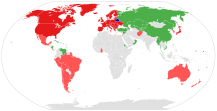More languages
More actions
(History) Tag: Visual edit |
No edit summary |
||
| Line 41: | Line 41: | ||
[[Category:Targets of regime change operations]] | [[Category:Targets of regime change operations]] | ||
[[Category:Countries targeted by imperialist aggression]] | [[Category:Countries targeted by imperialist aggression]] | ||
[[Category:European countries]] | |||
Revision as of 20:12, 17 December 2022
| Republic of Belarus Рэспубліка Беларусь | |
|---|---|
 | |
| Capital and largest city | Minsk |
| Official languages | Belarusian and Russian |
| Dominant mode of production | Capitalism with socialist characteristics |
| Leaders | |
• President | Aleksandr Lukashenko |
• Prime Minister | Roman Golovchenko |
| Area | |
• Total | 207,600 km² |
| Population | |
• 2021 estimate | 9,349,600 |
| Currency | Belarusian rouble (BYN) |
Belarus, officially the Republic of Belarus, is a landlocked country in Eastern Europe. In the aftermath of the Russian Revolution in 1917, different states arose competing for legitimacy, ultimately ending in the rise of the Byelorussian SSR, which became a founding constituent republic of the Soviet Union in 1922.
After the dissolution of the Soviet Union, Belarus declared independence and sought to maintain its state-owned economy under president Alexander Lukashenko. Belarus is relentlessly harassed by the imperialist West for refusal to privatize their state assets and embrace the neoliberal world order.[1]
History
Early history
Lithuania controlled what is now Belarus from the 13th to 18th centuries, and it was part of the Polish–Lithuanian Commonwealth after 1569. In 1795, Tsarist Russia conquered Belarus during the partition of Poland but Polish landlords and merchants continued to dominate the area.[2]
Soviet Union
Soviet Russia ceded the western part of Belarus to Poland in a 1921 peace treaty ending the Polish–Soviet War. The Red Army reunified Belarus in 1939.[2]
Capitalist era
In 1991, Soviet Union held a referendum on its preservation and 83% of Belarus's population voted to remain in the USSR.[3]
Stanislav Shushkevich, chairman of the Supreme Soviet of Belarus, signed the Belavezha Accords in December 1991 along with Leonid Kravchuk from Ukraine and Boris Yeltsin from Russia. This led to the illegal dissolution of the Soviet Union.[4]
2020 color revolution attempt

Following the 2020 presidential election where president Lukashenko was re-elected, Western Imperialist observers and their lapdogs criticized the results of the election, while promoting the anti-Lukashenko protestors in what appeared to be a US NGO-supported colour revolution.[5][6][7] The protestors were armed with Molotov cocktails.[8]
Arrest of terrorist Roman Protasevich
In 2021 the neo-Nazi terrorist Roman Protasevich boarded a flight from Greece to Lithuania. While the plane crossed over Belarusian airspace, it was ordered to land by state authorities.[9] Protasevich was a member of the neo-Nazi militant organisations Young Front, Pahonia Detachment, and fought alongside the neo-Nazi militant organisation Azov Battalion.[10]
The incident triggered a wave of denunciations by Western governments and aggressive sanctions on Belarus, since the US uses these neo-Nazi groups to advance their imperialist aims.[9][11]
Politics
The liberal Belarusian opposition is led by the Belarusian Popular Front and the United Civil Party.[8]
References
- ↑ Alan Macleod (2021-10-12). "US Writes Belarus into Its Familiar Regime-Change Script" MintPress News.
- ↑ Jump up to: 2.0 2.1 Albert Szymanski (1984). Human Rights in the Soviet Union: 'The European Nationalities in the USSR' (p. 85). [PDF] London: Zed Books Ltd. ISBN 0862320186 [LG]
- ↑ "Sowjetunion, 17. März 1991 : Weiterbestand der UdSSR als Föderation gleichberechtigter und souveräner Staaten" (1991-03-17). Direct Democracy. Archived from the original on 2022-02-19. Retrieved 2022-05-10.
- ↑ "Ex-Belarus leader Stanislav Shushkevich, who helped dissolve USSR, dies at 87" (2022-05-04). France 24. Archived from the original on 2022-05-06. Retrieved 2022-05-10.
- ↑ Dissident Voice (2020) Belarus: A Color Revolution of a Different Shade?
- ↑ The Moscow Times (2020) A Color Revolution in Belarus? Not Yet.
- ↑ Greanville Post (2020) Belarus – This Color Revolution Is Already Dead. The Union State Has Killed It.
- ↑ Jump up to: 8.0 8.1 Nadezhda Sablina (2022-07-19). "The Struggle for Belarusian Sovereignty: Interview with Belarusian Anti-Imperialist" Red Patriot. Archived from the original on 2022-07-19. Retrieved 2022-08-31.
- ↑ Jump up to: 9.0 9.1 The Grayzone (2021) US-funded Belarusian regime-change activist arrested on plane joined neo-Nazis in Ukraine
- ↑ FOIA research (2021) Roman Protasevich
- ↑ Shane Quinn (2019-04-19). "US and NATO's Ongoing Support for Neo-Nazis in Ukraine" Popular Resistance.


